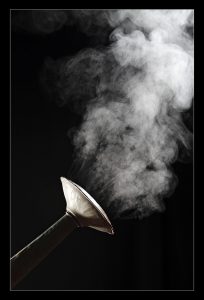
Steam Cleaners
Remove oil, water, metal, and dirt to reuse water again and again
Steam cleaners are used in many industrial applications to clean parts and equipment. Some major users of steam cleaning equipment include truck and bus washing, engine cleaning, and all types of repair facilities. Treating the waste streams generated from steam cleaner units operating in California has proven effective in separating the oil and water and removing metals and dirt from the water so the water can be reused.
One example is the waste water from a steam cleaner used to clean oil field service equipment which contains 8 ppm of chrome, lead, and zinc with lesser amounts of the other 17 metals on the states standard test along with a few ppm of oil and grease. At these concentrations the water is considered a hazardous waste with disposal costs ranging from $0.60 to $2.30 per gallon.
After treatment by electrocoagulation, the clear water met all federal secondary drinking water standards with the exception of surfactants. This was not a concern because the water was recycled through the steam cleaner and the recycled surfactants reduced the need to add soap to the steam cleaner system. It should be noted that charcoal could be used in conjunction with the EC process to make the water meet secondary drinking water standards. The sludge from the EC process contained 90 mg/kg oil and grease. The heavy metals were converted into oxides and the sludge passed the states TTLC and STLC as required by CAC title 22. As a result the State Health Board approved the EC processed sludge as a non hazardous waste.
| Steam Cleaner / Recycling of steam cleaner wash water (004-263) | |||
| Constituent | Wastewater (PPM) | EC Water (PPM) | % Removal |
| Antimony | <0.01 | 0.014 | – |
| Arsenic | 0.30 | <0.01 | 96.7%+ |
| Barium | 8.0 | <0.10 | 98.7%+ |
| Beryllium | <0.01 | <0.01 | – |
| Cadmium | 0.141 | 0.031 | 78% |
| Chromium | 7.98 | 0.05 | 99.4% |
| Cobalt | 0.13 | <0.05 | 61.5%+ |
| Copper | 6.96 | <0.05 | 99.3%+ |
| Lead | 7.4 | 1.74 | 76.5% |
| Mercury | 0.003 | <0.001 | 66.7% |
| Molybdenum | 0.18 | 0.035 | 80.7% |
| Nickel | 0.4 | <0.05 | 99.3%+ |
| Selenium | <0.005 | <0.005 | – |
| Silver | <0.01 | <0.01 | – |
| Thalliums | <0.10 | <0.10 | – |
| Vanadium | 0.23 | <0.01 | 95.7%+ |
| Zinc | 19.4 | 1.20 | 93.8% |
|
Dry sludge separated from the steam cleaner wastewater listed above (005-462) |
||||
| Element | TTLC Raw (mg/kg) | Max State | STLC Raw (mg/l) | Max State |
| Antimony | 2.4 | 500 | – | – |
| Arsenic | 3.85 | 500 | – | – |
| Barium | 307 | 10,000 | – | – |
| Beryllium | nd | 75 | – | – |
| Cadmium | nd | 100 | – | – |
| Chromium | 59.2 | 2,500 | – | – |
| Cobalt | 10.4 | 8,000 | – | – |
| Copper | 498 | 2,500 | 3.8 | 25 |
| Lead | 790 | 1,000 | – | – |
| Mercury | 0.15 | 20 | – | – |
| Molybdenum | 21.3 | 3,500 | – | – |
| Nickel | 25.5 | 2,000 | – | – |
| Selenium | nd | 100 | – | – |
| Silver | 2.7 | 500 | – | – |
| Thalliums | 14.2 | 700 | – | – |
| Vanadium | 42.1 | 2,400 | – | – |
| Zinc | 1,798 | 5,000 | 60 | 250 |
| Oil & Grease | 89,780 | – | – | – |
